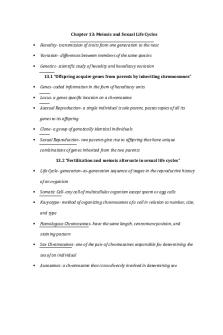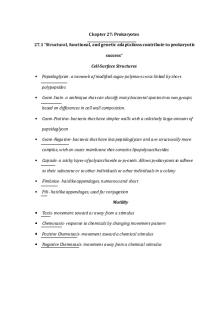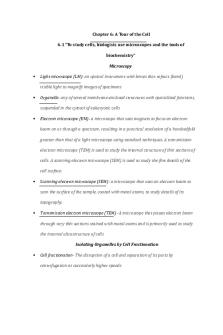Chapter 25 Vocab - Summary Campbell Biology PDF

| Title | Chapter 25 Vocab - Summary Campbell Biology |
|---|---|
| Course | Introduction to Biology A |
| Institution | University of Pennsylvania |
| Pages | 5 |
| File Size | 99.5 KB |
| File Type | |
| Total Downloads | 19 |
| Total Views | 142 |
Summary
Ch 25 Definitions...
Description
Chapter 25: Phylogeny and Schematics Investigating the Tree of Life
Phylogeny- the evolutionary history of a species or a group of species
Systematics- analytical approach to understanding the diversity and relationships of organisms, both present-day and extinct
Molecular Systematics- uses comparisons of DNA, RNA, and other molecules to infer evolutionary relationships between individual genes and even between entire genomes 25.1 “Phylogenies are based on common ancestries inferred from fossil, morphological, and molecular evidence” The Fossil Record
Fossil Record- sequence in which fossils have accumulated in strata Morphological and Molecular Homologies Sorting Homology from Analogy
Analogy- similarity between two species that is due to convergent evolution rather than to descent from a common ancestor with the same trait
Homoplasies- similar (analogous) structure or molecular sequence that has evolved independently in two species 25.2 “Phylogenetic systematics connects classification with evolutionary history”
Taxonomy- ordered division of organism into categories based on a set of characteristics used to assess similarities and differences
Binomial Nomenclature
Binomial- the two-part Latinized name of a species, consisting of genus and epithet
Genus- the first part of a species’ name, one above species in hierarchical classification
Specific Epithet- the second part of a species’ name, unique for each species within the genus Hierarchical Classification
Family- category above genus
Order- category above family
Class- category above order
Phyla- category above class
Kingdom- category above phyla
Domain- category above kingdom
Taxon- taxonomic unit at any level Linking Classification and Phylogeny
Phylogenetic Trees- branching diagram that represents a hypothesis about evolutionary relationships
25.3 “Phylogenetic systematics informs the construction of phylogenetic trees based on shared characters”
Cladogram- diagram depicting patterns of shared characteristics among species
Clade- group of species that includes an ancestral species and all its descendants
Cladistics- analysis of how species may be grouped into clades Cladistics
Monophyletic - pertaining to a grouping of species consisting of an ancestral species and all its descendants, a clade
Paraphyletic- grouping that consists of an ancestral species and some, but not all, of the descendants
Polyphyletic- grouping of several species that lack a common ancestor Shared Primitive and Share Derived Characters
Shared Primitive Character - character that is shared beyond the taxon that is trying to be defined
Shared Derived Character - an evolutionary novelty unique to a particular clade Outgroups
Outgroup- a species or group of species that is closely related to the ingroup
Ingroup- the various species that is being studied Phylogenetic Trees and Lining Phylograms
Phylogram- a phylogenetic tree in which the lengths of a branches reflect the number of genetic changes that have taken in a particular DNA or RNA sequence in the various lineages
Ultrametric Trees
Ultrametic Tree- a phylogenetic tree in which the lengths of the branch reflect measurements of geologic time
Maximum Parsimony and Maximum Likelihood
Maximum Parsimony- a principle that states that when considering multiple explanations for an observation, one should first investigate the simplest explanation that is consistent with the facts
Maximum Likelihood- a principle that states that when considering multiple phylogenetic hypotheses, one should take into account of the one that reflects the most likely sequence of evolutionary events, given certain rules about how DNA changes over time 25.4 “Much of an organism’s evolutionary history is documented in its genome” Gene Duplications and Gene Families
Orthologous Genes- refers to the homologous genes that are passed in a straight line from one generation to the next but have ended up in different gene pools because of speciation
Paralogous Genes- genes that result from gene duplication, so they are found in more than one copy in the same genome
25.5 “Molecular clocks help track evolutionary time” Molecular Clocks
Molecular Clock - a yardstick for measuring absolute time of evolutionary change based on the observation that some genes an other regions of genomes appear to evolve at constant rates Neutral Theory
Neutral Theory- much evolutionary change in genes and proteins has no effect on fitness and therefore is not influenced by Darwinian selection The Universal Tree of Life
Horizontal Gene Transfer - genes are transferred from one genome to another through mechanisms such as transposable elements, and perhaps through fusions of different organisms...
Similar Free PDFs

Ch26 - Summary Campbell Biology
- 6 Pages
Popular Institutions
- Tinajero National High School - Annex
- Politeknik Caltex Riau
- Yokohama City University
- SGT University
- University of Al-Qadisiyah
- Divine Word College of Vigan
- Techniek College Rotterdam
- Universidade de Santiago
- Universiti Teknologi MARA Cawangan Johor Kampus Pasir Gudang
- Poltekkes Kemenkes Yogyakarta
- Baguio City National High School
- Colegio san marcos
- preparatoria uno
- Centro de Bachillerato Tecnológico Industrial y de Servicios No. 107
- Dalian Maritime University
- Quang Trung Secondary School
- Colegio Tecnológico en Informática
- Corporación Regional de Educación Superior
- Grupo CEDVA
- Dar Al Uloom University
- Centro de Estudios Preuniversitarios de la Universidad Nacional de Ingeniería
- 上智大学
- Aakash International School, Nuna Majara
- San Felipe Neri Catholic School
- Kang Chiao International School - New Taipei City
- Misamis Occidental National High School
- Institución Educativa Escuela Normal Juan Ladrilleros
- Kolehiyo ng Pantukan
- Batanes State College
- Instituto Continental
- Sekolah Menengah Kejuruan Kesehatan Kaltara (Tarakan)
- Colegio de La Inmaculada Concepcion - Cebu














